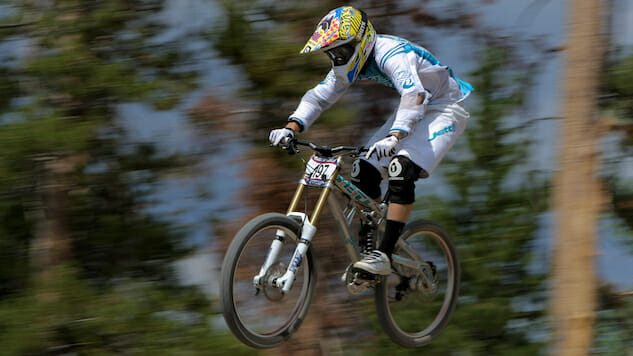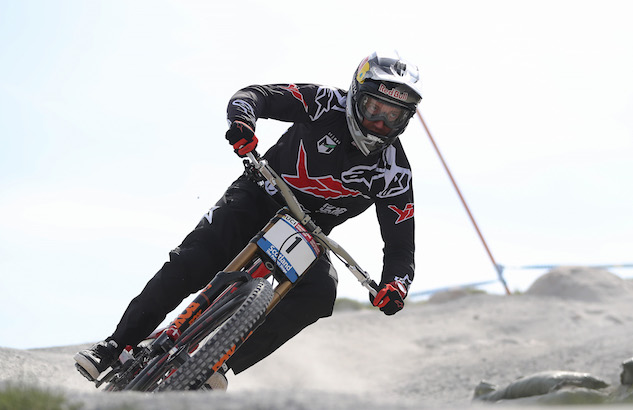Aaron Gwin on the Upcoming UCI Mountain Bike World Cup, Fitness and Grocery Shopping
Main photo by Doug Pensinger/Getty
Aaron Gwin is not the prototypical mountain bike racer you’d expect to see atop the UCI Mountain Bike World Cup. That is to say he is, by comparison, a relative new comer and in a field filled with and dominated by Europeans, he’s the lone American at the top. So how is it possible that a guy who just started mountain bike racing in 2008 and has only raced in the UCI series since 2011 is having such an impact? His previous stints as a BMX and Motocross racer gave him the background he needed to make the jump into the sport while an unparalleled devotion to fitness and nutrition has allowed him to dominate it since being there.
To say Gwin was young when he first started racing BMX bikes would be an understatement. He was four! As an outlet for his energy, BMX biking brought him all over the country to race, but like many child superstars, he burned out early, at the age of eight, and was back to being a normal little kid. That is until he picked up motocross, once again dominating the circuit, this time until he was forced out due to injury. The years spent racing both BMX and motocross proved invaluable to Gwin when he decided, on a whim, to pick up downhill mountain biking. Not only was the competition itself second nature, the BMX biking gave him an understanding of how to pedal based on terrain while the motocross taught him how to adjust to traveling at different speeds along different lines. This fundamental background enabled Gwin to dive right into racing mountain bikes professionally, however it was his commitment to fitness that surged him to the top of the rankings.

Photo by Ian MacNicol/Getty
The mountain biking circuit has always been known as a bit of a party scene. You’d ride your race and then head out for a few beers after it was over. To a degree, this still goes on, but not for Gwin. Mountain biking is his business and so is his approach to the sport. Perhaps that is why he has four UCI World Cup titles under his belt. With the UCI Mountain Bike World Cup Series kicking off on April 30th in France, you can check out Gwin on Red Bull TV, but in the meantime, we caught up with the American superstar to discuss his training and diet regimen and the impact it has had on his successful career. ![]()
Paste Health: How has the mountain biking circuit changed since you first came onto the scene? Are other athletes taking a more businesslike approach?
Aaron Gwin: Overall, there is more of a professional level of training. I came from motocross and didn’t have to train. If you were pretty fit and had some talent, you could win. Originally, there was partying at those races, but motocross had gone through the change where began riders focusing on training. When I came into mountain biking they hadn’t gone through that transition yet. It was headed in that direction, and I kind of finalized that. I wanted to be fit enough to ride from top to bottom. I took training more seriously and others followed.
PH: How have these changes impacted your approach to preparing for the UCI circuit?
AG: As the years go by and I get older, I learn more about my body. I find a weak spot and focus on fixing it, developing that spot so that it is no longer a deficiency. I also keep my training fun and fresh.
PH: How?
AG: My gym program was more specific a decade ago whereas now it is more diverse. Back then, I’d do three different workouts and just recycle them week to week. Now I am smarter, I know what I need. In November we begin with physical therapy movements, push pull exercises to work on imbalances. Working on fixing injuries. Once everything is strong and tight, then we shift to big weights, pushing heavier weights and varying the rep ranges from 8-20. As we get closer to the season, we ramp up the cardio with circuit training. We do a lot of plyometrics circuits, explosive and intense movements with short rest. We have fewer days off as well.

Photo by Ian MacNicol/Getty
-

-

-

-

-

-

-

-

-

-

-

-

-

-

-

-

-

-

-

-

-

-

-

-

-

-

-

-

-

-

-

-

-

-

-

-

-

-

-

-








































